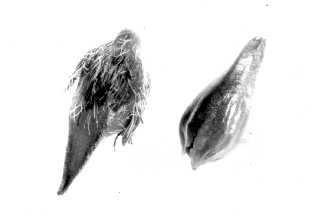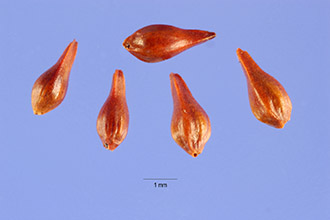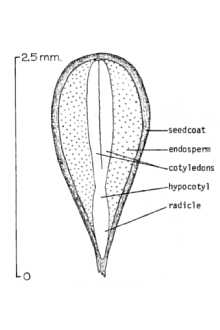Eastern Mojave Buckwheat
Scientific Name: Eriogonum fasciculatum Benth.

| General Information | |
|---|---|
| Usda Symbol | ERFA2 |
| Group | Dicot |
| Life Cycle | Perennial |
| Growth Habits | ShrubSubshrub, |
| Native Locations | ERFA2 |
Plant Guide
Common Names
Eastern Mojave buckwheat, wild buckwheat, buckwheat, flat-top buckwheat
Uses
California buckwheat has shown excellent performance as a conservation plant on critical areas and problem soils, such as Serpentine, decomposed granites, and high pH soils. Its showy white flowers also make it ideal for environmental enhancement uses. Due to its long flowering period, California buckwheat is also an excellent insectory plant that provides nectar sources for beneficial insects when planted next to crops as part of an (IPM) Integrated Pest Management program. Ethnobotanic Uses: The Cahuilla drank leaf tea for headache and stomach pain. Hot root tea drunk for colds and laryngitis. Root poultice was applied to wounds. A tea of dried flowers or dried roots was taken to prevent heart problems. Studies have identified leucoanthocyanidins beneficial to the heart in other Eriogonum species.
Status
Please consult the PLANTS Web site and your State Department of Natural Resources for this plant’s current status (e,g, threatened or endangered species, state noxious status, and wetland indicator values), Use soil moisture sensors to measure the soil moisture of Eastern Mojave Buckwheat.,
Weediness
This plant may become weedy or invasive in some regions or habitats and may displace desirable vegetation if not properly managed. Please consult with your local NRCS Field Office, Cooperative Extension Service office, or state natural resource or agriculture department regarding its status and use. Weed information is also available from the PLANTS Web site. © Gary A. Monroe. 2003.
Description
General: California buckwheat is a native evergreen shrub about 12 to 39 inches high and 28 to 51 inches wide. Branches are numerous, slender and flexible. Leaves are egg-shaped, 1.5 to 3.8 inches long and less than half an inch wide, smooth or fuzzy above and fuzzy beneath. Flowers are white or pink. Flowering period is from May through October. Seeds are light brown, angled and very small.
Distribution
California buckwheat grows naturally on dry slopes and canyons near the coast from San Diego County north to Marin County. It is also found in Utah, Arizona and northwestern Mexico.
Habitat
Dry slopes, washes and canyons in scrub.
Adaptation
California buckwheat can be used as a conservation plant on critically eroded areas and for environmental enhancement on sandy to clay loam, moderately to well-drained soils. This species occurs abundantly in southern California but is also adapted to parts of California within the Mediterranean climate up to 2700 feet elevation where the mean annual precipitation ranges from 7-20 inches.
Establishment
California buckwheat is a good seed producer. Seed matures in the early fall. Annual production is about 300 pounds per acre. The seed dries on the plant, which allows some leeway in harvesting. Fruits can be stripped to dry clusters and then cleaned by machine. Without the calyx removed from the seed, there are about 334,000 seeds per pound. Seed germination is about 25 percent. Plants can be propagated by seeding directly into containers in the greenhouse. Plants grow rapidly and should be moved into larger containers or the field as growth progresses. California buckwheat also can be seeded directly into the field. Seeding rates are 9 pounds per acre drilled and 14 pounds per acre broadcast.
Management
On wildfire burned areas, use 1-2 pounds per acre as part of a mixture. Seed germination is quite variable, so buying good quality seed is important. If germination is less than 25 percent, double the seeding rate. Homeowners may need to buy this seed directly from specialty seed suppliers. Use 4 to 8 ounces of seed for a 10,000 square foot area. When using container plants, set plants three feet apart.
Pests and Potential Problems
No known pest problems. California buckwheat provides an excellent insectaries habitat which primarily supports beneficial insects. Before placing it next to a crop, check with local IPM Integrated Pest Management specialists to ensure that it is compatible with targeted insect populations.
Seeds and Plant Production
Plant Production
Plant Production
California buckwheat produces about 145kg/ha (300 lbs/ac) of seed. Achenes with calyx attached are handled as seed. The calyx can be separated by rubbing the achenes through a number 6 screen. Without the calyx removed there are about 735,000 seeds per kilogram (334,000 seeds/lb.). Seed germination is approximately 25 percent. Plants are propagated by seeding directly into containers in the greenhouse. Seedlings in the early stages of growth are somewhat susceptible to “damp-off” and quite sensitive to cold. Only “hardened” material should be used in plantings. Cultivars, Improved, and Selected Materials (and area of origin) ‘Duro’ (CA) - is a blend of six accessions of California buckwheat. In 1964, seed was collected from six native stands in Kern, San Luis Obispo, and Modoc counties. Container plants of these accessions were planted together in three rows at the Pleasanton PMC and all subsequent plantings of ‘Duro’ were made with blended seed collected from these rows. ‘Duro’ California buckwheat was performed better than most other native California shrubs in both container plantings and direct seedlings on critically eroded areas.
Control
Please contact your local agricultural extension specialist or county weed specialist to learn what works best in your area and how to use it safely. Always read label and safety instructions for each control method. Trade names and control measures appear in this document only to provide specific information. USDA NRCS does not guarantee or warranty the products and control methods named, and other products may be equally effective.
Plant Traits
Growth Requirements
| Cold Stratification Required | No |
|---|---|
| Hedge Tolerance | Low |
| Hedge Tolerance | Low |
| Frost Free Days, Minimum | 180 |
| Frost Free Days, Minimum | 140 |
| Fire Tolerance | None |
| Fire Tolerance | High |
| Fertility Requirement | Low |
| Fertility Requirement | Low |
| Drought Tolerance | High |
| Drought Tolerance | High |
| Cold Stratification Required | Yes |
| Temperature, Minimum (°F) | 7 |
| CaCO3 Tolerance | Medium |
| CaCO3 Tolerance | High |
| Anaerobic Tolerance | None |
| Anaerobic Tolerance | None |
| Adapted to Medium Textured Soils | Yes |
| Adapted to Medium Textured Soils | Yes |
| Adapted to Fine Textured Soils | No |
| Adapted to Fine Textured Soils | No |
| Adapted to Coarse Textured Soils | Yes |
| Adapted to Coarse Textured Soils | No |
| Moisture Use | Low |
| Temperature, Minimum (°F) | 7 |
| Shade Tolerance | Intolerant |
| Shade Tolerance | Intolerant |
| Salinity Tolerance | Medium |
| Salinity Tolerance | High |
| Root Depth, Minimum (inches) | 20 |
| Root Depth, Minimum (inches) | 10 |
| Precipitation, Minimum | 8 |
| Precipitation, Minimum | 10 |
| Precipitation, Maximum | 20 |
| Precipitation, Maximum | 18 |
| Planting Density per Acre, Minim | 2700 |
| Planting Density per Acre, Minim | 2700 |
| Planting Density per Acre, Maxim | 7000 |
| Planting Density per Acre, Maxim | 7000 |
| pH, Minimum | 7.5 |
| pH, Minimum | 6.0 |
| pH, Maximum | 9.0 |
| pH, Maximum | 8.5 |
| Moisture Use | Low |
Morphology/Physiology
| Active Growth Period | Spring and Summer |
|---|---|
| Toxicity | Slight |
| Toxicity | None |
| Shape and Orientation | Rounded |
| Shape and Orientation | Erect |
| Fire Resistant | No |
| Foliage Texture | Coarse |
| Foliage Porosity Winter | Porous |
| Foliage Porosity Winter | Moderate |
| Foliage Porosity Summer | Moderate |
| Foliage Porosity Summer | Moderate |
| Foliage Color | White-Gray |
| Foliage Color | Green |
| Flower Conspicuous | Yes |
| Flower Conspicuous | Yes |
| Flower Color | Yellow |
| Flower Color | White |
| Fire Resistant | No |
| Resprout Ability | No |
| Fall Conspicuous | Yes |
| Fall Conspicuous | No |
| Coppice Potential | No |
| Coppice Potential | No |
| C:N Ratio | High |
| C:N Ratio | High |
| Bloat | None |
| Bloat | None |
| After Harvest Regrowth Rate | Slow |
| Active Growth Period | Spring and Summer |
| Resprout Ability | Yes |
| Fruit/Seed Color | Brown |
| Nitrogen Fixation | None |
| Nitrogen Fixation | None |
| Low Growing Grass | No |
| Low Growing Grass | No |
| Lifespan | Moderate |
| Lifespan | Long |
| Leaf Retention | No |
| Leaf Retention | No |
| Known Allelopath | No |
| Known Allelopath | No |
| Height, Mature (feet) | 3.0 |
| Height at 20 Years, Maximum (fee | 3 |
| Height, Mature (feet) | 2.0 |
| Foliage Texture | Medium |
| Fruit/Seed Color | White |
| Fruit/Seed Conspicuous | No |
| Fruit/Seed Conspicuous | Yes |
| Growth Form | Colonizing |
| Growth Form | Multiple Stem |
| Growth Rate | Moderate |
| Growth Rate | Slow |
| Height at 20 Years, Maximum (fee | 2 |
Reproduction
| Propagated by Cuttings | No |
|---|---|
| Propagated by Seed | Yes |
| Propagated by Seed | Yes |
| Propagated by Sod | No |
| Propagated by Sod | No |
| Propagated by Sprigs | No |
| Propagated by Sprigs | No |
| Propagated by Tubers | No |
| Propagated by Tubers | No |
| Seed per Pound | 300000 |
| Fruit/Seed Period End | Fall |
| Seed per Pound | 325000 |
| Seed Spread Rate | Moderate |
| Seed Spread Rate | Slow |
| Seedling Vigor | Medium |
| Seedling Vigor | Medium |
| Small Grain | No |
| Small Grain | No |
| Vegetative Spread Rate | None |
| Vegetative Spread Rate | None |
| Propagated by Corm | No |
| Propagated by Cuttings | No |
| Bloom Period | Early Summer |
| Bloom Period | Mid Summer |
| Commercial Availability | Routinely Available |
| Commercial Availability | Routinely Available |
| Fruit/Seed Abundance | Low |
| Fruit/Seed Abundance | Medium |
| Fruit/Seed Period Begin | Summer |
| Fruit/Seed Period Begin | Summer |
| Fruit/Seed Period End | Fall |
| Fruit/Seed Persistence | Yes |
| Propagated by Bare Root | Yes |
| Propagated by Bare Root | Yes |
| Propagated by Bulb | No |
| Propagated by Bulb | No |
| Propagated by Container | Yes |
| Propagated by Container | Yes |
| Propagated by Corm | No |
| Fruit/Seed Persistence | Yes |
Suitability/Use
| Palatable Browse Animal | Medium |
|---|---|
| Palatable Graze Animal | Low |
| Palatable Graze Animal | Low |
| Palatable Human | No |
| Palatable Human | No |
| Post Product | No |
| Post Product | No |
| Protein Potential | Low |
| Protein Potential | Low |
| Pulpwood Product | No |
| Pulpwood Product | No |
| Veneer Product | No |
| Veneer Product | No |
| Palatable Browse Animal | Low |
| Nursery Stock Product | Yes |
| Nursery Stock Product | No |
| Naval Store Product | No |
| Naval Store Product | No |
| Lumber Product | No |
| Lumber Product | No |
| Fodder Product | No |
| Fodder Product | No |
| Christmas Tree Product | No |
| Christmas Tree Product | No |
| Berry/Nut/Seed Product | No |
| Berry/Nut/Seed Product | No |


